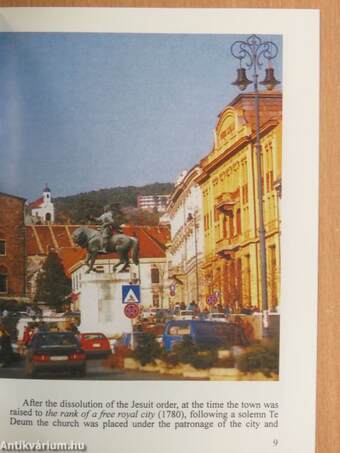1.103.847
kiadvánnyal nyújtjuk Magyarország legnagyobb antikvár könyv-kínálatát

VISSZA
A TETEJÉRE
JAVASLATOKÉszre-
vételek
Pécs - Inner City Parish Church
Pécs - Belvárosi plébániatemplom
| Kiadó: | Tájak-Korok-Múzeumok Egyesület |
|---|---|
| Kiadás helye: | Budapest |
| Kiadás éve: | |
| Kötés típusa: | Tűzött kötés |
| Oldalszám: | 16 oldal |
| Sorozatcím: | Tájak-Korok-Múzeumok Kiskönyvtára |
| Kötetszám: | 297C |
| Nyelv: | Angol |
| Méret: | 16 cm x 12 cm |
| ISBN: | 963-554-372-7 |
| Megjegyzés: | Fekete-fehér és színes fotókkal, alaprajzokkal illusztrálva. |
naponta értesítjük a beérkező friss
kiadványokról
naponta értesítjük a beérkező friss
kiadványokról
Előszó
The monumental architectonic mass of Gazi Kasim jami (a type of mosque) dominates Széchenyi Square, the main square of the city. In the Middle Ages the more proportioned and more fitting Church... Tovább
Előszó
The monumental architectonic mass of Gazi Kasim jami (a type of mosque) dominates Széchenyi Square, the main square of the city. In the Middle Ages the more proportioned and more fitting Church of St Bartholomew stood in its place, acting as the centre of this lively civil town which boasted its own markét place, town hall and many single-or two-storey houses belonging to wealthy citizens.
The conquering Turks did not destroy the structure of the town: the crops of the conquered country were still exchanged at the markét place. But in place of the Christian churches, from their stones they raised jamis and mosques in honour of Allah and his prophet.
After the overthrow of the Turkish occupiers, the jami was transformed into a Catholic church which took on its present form in the 1930s, all the while preserving and displaying the values of the past.
The history of the parish church
In the course of excavations during the 1930s, the votive altar stone (240 AD) of Cicereius Homuncio, the consular beneficiary of the number one Román non-combatant légion serving the security of Sopianae (the Román name of Pécs), was found in the neighbourhood of a rich tomb in the foundation wall of the north-east porch of the jami.
The 16 graves excavated in the northern part of the square used to be a part of the burial ground stretching as far as the cathedral in the third and fourth centuries. Our first king, St Stephen, allocated the site of the pontifical cathedral of Pécs on the northern territory of this area in 1009.
The markét centre of the town developing at the foot of the Bishop's Castle coalesced around today's Széchenyi Square. The citizens, mainly French and Walloons at that time, built their first parish church here (consecrated in honour of Apostle St Bartholomew) during the governorship of the French Bishop Bartholomew in the mid-thirteenth century.
The single nave Romanesque church terminating in a sanctuary survived even the Mongol invasion of Hungary in 1241-42, although it was seriously damaged in 1299: the Mohammedan-Böszörmény palatine Mizse (a palatine used to be the highest administrative dignitary in feudal Hungary before 1848) set the city on fire out of revenge and the church was burnt to ashes together with the mainly thatched, single-storey houses of the town.
By about 1308 the town, awakened from its ashes, ranked as one of the 10 major úrban centres of the country. In the 1330s it was the Vissza
Témakörök
- Idegennyelv > Idegennyelvű könyvek > Angol > Művészetek > Építészet
- Idegennyelv > Idegennyelvű könyvek > Angol > Útikönyvek
- Idegennyelv > Idegennyelvű könyvek > Angol > Vallás > Kereszténység
- Idegennyelv > Idegennyelvű könyvek > Angol > Helytörténet
- Helytörténet > Helyismeret > Várak, építmények
- Útikönyvek > Idegennyelvű útikönyvek > Angol
- Útikönyvek > Magyarország > Dunántúl > Városai
- Útikönyvek > Utazás, turizmus
- Útikönyvek > Természetjárás, túrák > Városnézés
- Művészetek > Építészet > Kontinensek szerint > Európa > Magyar > Egyéb
- Művészetek > Építészet > Kontinensek szerint > Ázsia > Iszlám
- Művészetek > Építészet > Idegen nyelv > Angol
- Művészetek > Építészet > Műemlékek > Vallási
- Vallás > Kereszténység > Magyarországon > Templomok
- Vallás
- Vallás > Kereszténység > Egyházművészet > Építészet
Megvásárolható példányok
Nincs megvásárolható példány
A könyv összes megrendelhető példánya elfogyott. Ha kívánja, előjegyezheti a könyvet, és amint a könyv egy újabb példánya elérhető lesz, értesítjük.





